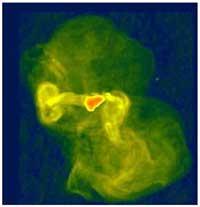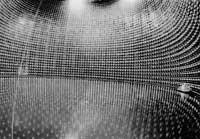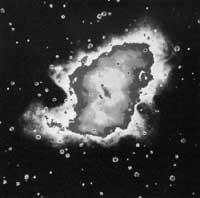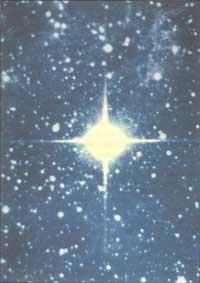Dark matter for information
2000/04/09 Kortabarria Olabarria, Beñardo - Elhuyar Zientzia
Most of the universe is called dark. It does not appear on the electromagnetic spectrum, so it is not visible. Dark matter light may be very weak, so current astronomical tools will not be able to detect. But it is there, even if it is not seen, it can be detected. And according to the calculations made, in the universe only 10% can be seen. For example, galaxies would be within that 10%, surrounded by dark matter. According to experts, dark matter had a lot to do with galaxy formation.

The existence of dark matter was discovered in 1932 thanks to the work of astronomer Jan Oort. That astronomer was investigating the influence of the gravity of the Milky Way on the surrounding stars, and thus was able to measure the mass of the Milky Way disk. He had a great surprise, since the mass that had been extracted was double that the stars and nebulae that could be seen. A year later, astronomers Fritz Zwicky and Sinclair Smith, while studying galaxy sets, drew a similar but more surprising conclusion: galaxies that could be seen represented only 10% of the mass needed to gravity-trigger the galaxy set. The set of galaxies they were observing had to be broken in theory, since the intergalactic gravitational attraction was much smaller than the kinetic energy of galaxies, that is, the whole had to be broken, but it was not broken. Hence it was deduced that, in order for the galaxy sets to be grouped, there must be something that added mass, dark matter.
Since then dark matter tests have been found on several occasions. Perhaps the highlight in 1972 R. Brent Tullyk and J. Richard Fischer was a research presented by scientists. Both people conducted a 9-year investigation. During this time some 2,200 galaxies located in the group of galaxies called Virgo were analyzed. Within the Virgo galaxy cluster is the huge elliptical galaxy known as M-87. In the orbit of this galaxy there are numerous small galaxies, stars and masses of hot gas. The friction generated by the gravity force of the galaxy M-87 causes all these bodies to generate X-rays. Around the Virgo galaxy cluster there is a ring of galaxies with a diameter of 35 million light years. This ring cannot be collected only by the gravity of the galaxies in it, as these galaxies move very quickly. Therefore, the only thing that maintains the whole structure can be dark matter.
In short, dark matter seems to be the skeleton of large structures. And this is surprising, since most of the dark matter is made up of elementary particles, that is, the larger things that are known are formed by the small things that are known.
Dark matter in cosmology
According to some astronomers, protons and neutrons are the components of dark matter, so to speak, "conventional" components. Planets, comets, objects unable to launch the fusion of hydrogen -brown dwarfs, traces of stars -cold white dwarfs, and some gases would enter this previous group. Others consider as "abnormal" particles the components of dark matter that are not able to interact with common matter. Except for neutrinos, these unconventional particles still exist theoretically because they have not been detected.
And all of the above is important? Yes, and it's amazing.
In cosmology there is a parameter known as critical density. This parameter sets the boundary between the belief that the universe is constantly expanding and the contraction and collapse of the universe. If the density of matter in the universe were greater than that critical density, the universe would contract, while if it were less the universe would continue to grow. Therefore, to know what will be the fate of the universe it is essential to know the matter.
To count this matter, you can only tell what is in sight today - stars, galaxies, nebulae... - but there is also dark matter, the question is that how much and what kind of dark matter there is. In fact, conventional dark matter, formed by neutrinos, for example, and unconventional, such as neutraline.
Following Hawking's theories, in the early 1990s the American scientist Denis Sciama opted for the neutrino theory, according to which neutrinos, small particles without electric charge but with mass, would be able to curb the expansion of the universe. According to this, if the universe had enough weight, the force of gravity would prevail over the capacity of expansion and expansion would be stopped, while if there were less mass - less dark matter, otherwise - the expansion of the universe would not be interrupted. With the aim of clarifying the debate, three years ago the satellite Minisat was launched into space, with the aim, among others, of conducting an experiment prepared by Dennis Sciama to investigate dark matter. In April last year the first data were collected, but Sciama himself said that little was clarified. Months later, in September, a group of Spanish astrophysicists noted that there were miscalculations in Sciama's theories, that neutrinos were not able to curb the expansion of the universe, so the universe will expand constantly.
Debate, the clarification of dark matter, will open the door of universe destiny.
Published in 7

Gai honi buruzko eduki gehiago
Elhuyarrek garatutako teknologia





